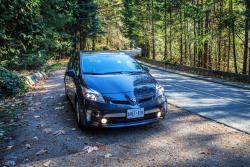Well, they can’t all be Hellcats. But wait, if we’re praising automotive extremes, then should not the Prius get a little more love than it does? The fastest, the toughest, the quickest to sixty; any vehicle with outstanding attributes gets the accolades, so why not the penny-pinchingest? Here it is, the gasoline-powered car that uses just about the least amount of fuel possible.
Now, the Prius is not very exciting to look at. Or sit in. Or drive. In fact, the only real excitement I’ve ever felt in one of these things is as a passenger in a taxicab driven by a gent who clearly missed his calling as a participant in Death Race 2000. Last time I drove a Prius, I described the experience as being buried in a pool filled with packing peanuts and the analogy stands. It’s not much fun and there’s no point fighting it.
But that doesn’t mean there’s not some likability to be found here. This is the plug-in variant of Toyota’s Prius, and it has a few tricks up its beige sleeve.
It’s an immediately recognizable shape, halfway between an orthopaedic shoe and an ergonomic mouse. Design analysis irrelevant – here, form follows function and the Prius is as slippery as you could hope for, with a coefficient of drag of just 0.25. Hardly anything is better this side of a Bonneville speedweek slipstreamer.
Plus, no giant gaping grills and faux aggression, which is great. The Prius is merely a background sort of car, and has been on the road so long it’s not even a statement any more. The days when Leo DiCaprio showed up to the Oscars in a Prius and South Park lampooned owners for being insufferably smug are over. For the most part, the Prius is now just a tool in the driveway, one designed to burn as little fuel as possible. It’s a noble aim.
However, step into this aging car’s interior and experience a few of the drawbacks of economy above all else. While it’s spacious and relatively comfortable (the liftback trunk is particularly useful), there’s also a strong element of cheapness here, and a pretty low-tech dashboard layout. The plastic surfaces feel hard and brittle, the greenish glow of the centre-mounted instrument panel is outdated, and the Softex-covered pleather seats look like their coverings came straight from the inflatable cow ranch. Some of the ergonomics are suspect too, like the nearly floor-mounted heated seat controls.
  2015 Toyota Prius PHEV, dashboard. Click image to enlarge |
You can live with the Prius’s insides, but it’s not a particularly pleasant place to be, and given the relatively high price of this PHEV, something of a letdown. Some stuff to like includes the Touch Tracer function for the steering wheel controls – hover a thumb over them and they pop up in the centre display, right in your line of sight and meaning you don’t have to glance downwards.
And, as I’ve said, it is a relatively comfortable car. The seating is good front and back, and the infotainment screen is easy enough to scroll through. I had a bit of an issue with the display not turning to night mode when the headlights were on, but managed to get it sorted with a system reset. Other than that, it’s a simple enough car to drive, just pop the little blue shifter into D and off we go.
As a bit of a challenge, I elected to hustle my tester up the hilly road to Whistler. This is a lovely bit of tarmac, if somewhat low speed in places, and as the Prius had winter tires fitted anyway, would be a good exercise in cold weather fuel economy.
Part of the reason that there is essentially no interior space penalty for ordering the plug-in version of Toyota’s hybrid over the standard car is that the swap doesn’t require a bigger battery, just a slightly more capacious one. Standard Priuses have a 1.3-kWh nickel-hydride battery, where the plug-in variant gets a 4.3-kWh lithium-ion electric fuel tank. Charging it up is a relatively quick affair, taking just three hours on a 120V plug, or half that on a 240V.
Tackling the twisting tarmac, well, the Prius PHEV’s steering is nothing to write home about. Well actually, maybe it is.
   2015 Toyota Prius PHEV charging port, engine, shifter. Click image to enlarge |
Dear Home,
All going well. Steering in Prius is as numb as the end of Captain John Franklin’s frozen nose. Fuel economy pretty good though.
-Love, Brendan
Aside from the 1998 Buick Century steering feel, I have two main beefs with the Prius PHEV’s on-road behaviour. First, the power delivery in Eco mode is almost laughably feeble. Hit power for a quick on-ramp boost and the Prius actually scoots with relative aplomb. Leave it in Eco and it feels like it’s really struggling up the hills. The combined power of the 1.8L four-cylinder engine and the electric motor is 138 hp, which would be plenty of pep in something like a Honda Civic, but the Prius really feels a bit overtaxed on the hilly sections.
The second issue is the way it doles out the electricity, which is both smart, and at the same time frustrating. Basically, the plug-in Prius uses its electric charge as a little added power to supplement the gasoline engine, so it’s always turning it on and shutting it off. There’s almost no way to cruise along at any speed without kicking on the gas motor, unlike other hybrids, which allow for gas-free cruising on the flats.
   2015 Toyota Prius PHEV steering wheel, Hybrid System Indicator, cargo area. Click image to enlarge |
However, when I turned around and headed back into Vancouver, the Prius actually wasn’t half bad. The headlights are excellent, the grip is actually acceptable thanks to the seasonally appropriate rubber, and it was possible to keep up something of a momentum run on the downhill sections. Best of all, the engine only kicked on periodically, and when time came to evaluate how much fuel had been used, the number was just over 3 L/100 km. That’s with a just a single charge in the battery on the way up.
Impressive, and even more so was the economy over the next few days of puttering around in town. Here, with the Prius PHEV plugged in once an evening, the observed fuel economy was more like 2.5 L/100 km, and probably would have been even better if not for a sudden cold snap that required running the heater.
There’s more to like too. One of the main arguments against any hybrid system is the relative price increase over a conventionally powered economy car, especially with many compacts not as entry-level as they used to be. However, the Prius isn’t just going to save you on fuel costs; maintenance items like brakes, oil changes, and so on are all much more infrequent than in a regular car. In fact, taxi companies see far greater savings from cost savings here than in outright fuel-economy benefits. Perhaps that’s why they all seem to drive with their right foot welded to the floorboards.
Plus David Suzuki has one, so you can feel good about yourself for driving a green option, right? Well, not so much. In fact, while the Prius PHEV is plenty efficient and inexpensive to operate, it does have one big problem. It’s called the Prius.
The ordinary Prius is fitted with a smaller battery that’s actually better at delivering a short burst of power, and is thus a little quicker feeling than the plug-in car. It’s not quite as efficient, but the gap in price eats up any potential fuel savings. Taking the 2015 model year five-cycle ratings, the mixed-mileage difference between the pair is 2.2 L/100 km. Assume gasoline prices will increase to around $1.50/L and figure an average of 20,000 km per year, and we’d be looking at a decade to make up the $6K+ gap between the standard car and the plug-in when both are equivalently equipped. Oof – even if the plug-in holds a percentage of value on resale, that’s a yawning gulf.
   2015 Toyota Prius PHEV, headlight. Click image to enlarge |
But wait! If you’re reading this in Toronto, then good news – the government will give you a $5K rebate to swallow up that cost. And there’s a similar program in Quebec. It’s a no-brainer then: a grand for extra plug-in capacity? Absolutely. If you live elsewhere like in rebate-free BC, as I do, then cue the sad trombone noise.
Plus, if we’re looking at rebate-eligible cars why not a Nissan Leaf then? Or the excellent electric version of the Kia Soul? Both provide enough range for the average Canadian consumer concerned about emissions.
With a new Prius on the way by next year with updated interior, exterior, handling, and powertrains, the average consumer is probably best off with the regular version. If you can get a cut-rate price on one of these machines, well, it’s not much fun, but it is most certainly functional.
|
Manufacturer’s Website: Toyota Canada Photo Gallery: Crash Test Results: |
Pricing: 2015 Toyota Prius PHEV
Base price: $35,705
Base price with Technology Package: $40,940
Options: None
Freight: $1,620
A/C tax: $100
Price as tested: $42,660
Competitors:
Chevrolet Volt
Ford C-Max Energi
Ford Fusion Energi
Honda Insight
Kia Soul EV
Nissan Leaf















